Did you know the Ficus Bonsai is the easiest indoor bonsai tree to care for? These tiny trees can make any room feel peaceful, whether it’s an office or a home. There are many types of bonsai trees perfect for indoor gardens, fitting every taste and skill level.
If you’re new to bonsai or already love them, there’s a wide range to discover. Species like the Dwarf Jade, Fukien Tea, and Hawaiian Umbrella can make your space look amazing. These plants are small, easy to care for, and can brighten up any room.
Key Takeaways
- Indoor bonsai trees come in a variety of species, including the popular Ficus, Dwarf Jade, and Fukien Tea.
- These miniature trees can add a touch of natural beauty and tranquility to any indoor space.
- Bonsai trees suitable for indoor cultivation often have specific light, humidity, and temperature requirements.
- Proper care and maintenance, such as watering, pruning, and repotting, are essential for the long-term health of indoor bonsai.
- Choosing the right indoor bonsai tree based on your skill level and desired aesthetic can greatly enhance your living environment.
Popular Indoor Bonsai Tree Species
Some bonsai tree species are more popular for indoor growth. The Ficus Bonsai, Dwarf Jade, and Fukien Tea are top picks. They are great for indoor settings.
Ficus Bonsai
The Ficus Bonsai is known for its toughness and ability to handle low light. It’s perfect for both new and seasoned bonsai lovers. Its beautiful leaves and detailed trunk make it a hit with indoor growers.
Dwarf Jade
The Dwarf Jade is another favorite for indoor bonsai. It’s a succulent that grows slowly and likes low humidity. Its thick leaves and easy care make it great for indoor bonsai fans.
Fukien Tea (Carmona)
The Fukien Tea, or Carmona, is also popular for indoor bonsai. It’s from Southeast Asia and does well in low light and humidity. Its pretty leaves and flowers add beauty to any indoor bonsai setup.
The Ficus Bonsai, Dwarf Jade, and Fukien Tea are top picks for indoor bonsai. They offer different traits that meet the needs of bonsai lovers at home or in offices.
“Approximately 1% of all tree species are considered suitable for indoor bonsai, according to Ryan’s opinion in the provided material.”
Benefits of Growing Bonsai Trees Indoors
Adding bonsai trees to your home brings many benefits. They make your space look better and help clean the air, reduce stress, and bring peace.
Bonsai trees are great at purifying the air. They remove pollutants and toxins, making your home healthier. This is perfect for those wanting a cleaner indoor environment.
“Bonsai plants have been cultivated and cared for in China for over a thousand years.”
They also help lower stress and blood pressure. Being around these trees can make you feel more relaxed. Studies show that caring for bonsai can improve your mental and physical health.
- Bonsai plants are beneficial to one’s health, aiding in the treatment of coughs, weariness, sore throats, and exhaustion.
- Bonsai plants are popular in homes as stress relievers and can also be found on workplace workstations in various businesses.
- Regular care for bonsai plants, such as watering, fertilization, and pruning, promotes physical activity and patience development.
Plus, growing bonsai can be a fun and fulfilling hobby. It teaches patience, consistency, and attention to detail. Taking care of a bonsai can be like meditation, improving your self-awareness and decision-making.
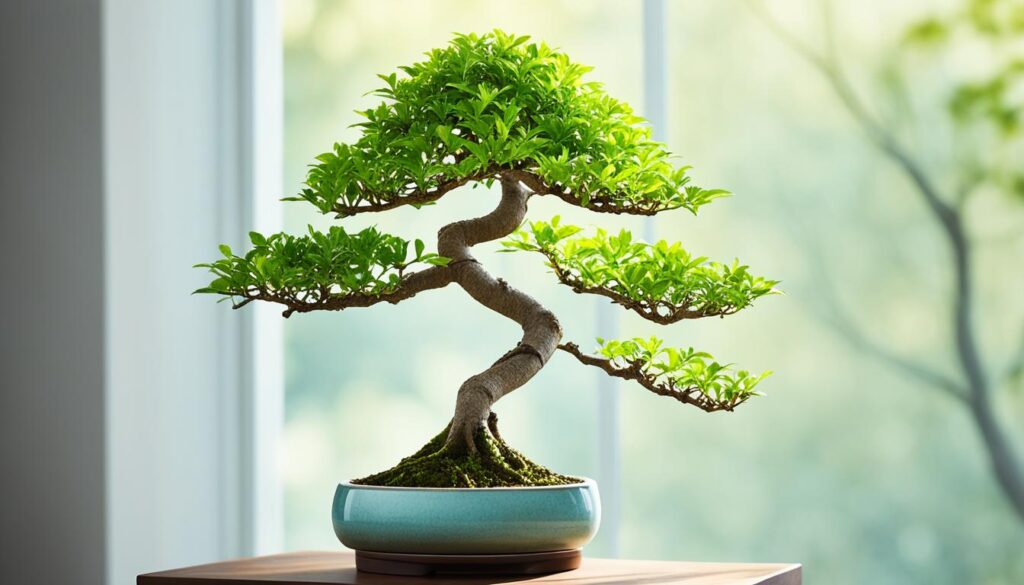
So, bonsai trees offer more than just beauty. They improve air quality, reduce stress, and help develop patience and creativity. Adding bonsai to your home brings tranquility and nature indoors. It’s a unique way to enjoy these remarkable trees.
Selecting the Right Indoor Bonsai Tree
Choosing an indoor bonsai means looking at the tree’s needs. Tropical and subtropical bonsai work well inside because they don’t need to sleep through the seasons. It’s also key to think about the growth habits and mature size to make sure the tree fits your space and does well indoors.
Tropical vs. Subtropical Species
Tropical and subtropical bonsai trees are great for indoor gardens. They adjust well to the steady temperature and light inside. These trees skip the winter sleep, so they’re perfect for being indoors all year.
Growth Habits and Size
When picking bonsai for indoor spots, think about how big and how the tree grows. Small, slow-growing trees are usually best for indoor bonsai. They won’t get too big too fast, keeping their shape in your space.
For beginners, the Ficus, Chinese Elm, and Jade tree are top picks. They’re tough and fit well inside. With the right care, like watering, pruning, and feeding, these bonsai tree growth will flourish.
“Choosing the right indoor bonsai is essential for the tree’s long-term health and your enjoyment of the art form.”
By looking at the needs of tropical vs subtropical bonsai and their growth, you can pick a bonsai that will do great in your place.
Caring for types of bonsai trees indoor
To keep indoor bonsai trees healthy and vibrant, you need to know their light and humidity needs. Proper caring for indoor bonsai is key to their success at home.
Light Requirements
Most bonsai trees need a lot of light to grow well indoors. Place your bonsai near a sunny window or use artificial lighting to help. Tropical bonsai like Ficus and Fukien Tea need lots of light. On the other hand, Dwarf Jade and other subtropical types can handle less light.
Humidity Needs
- Keeping the right humidity is crucial for bonsai plants indoors.
- Use humidity trays or mist the leaves often to keep them from drying out.
- Tropical bonsai, like Ficus, need more humidity than subtropical ones.
- Watch how your bonsai reacts and adjust the humidity to keep it healthy and growing well.
“Properly caring for your indoor bonsai is the key to keeping these miniature marvels thriving in your home.”
Knowing the light and humidity needs of your bonsai is key to keeping it healthy and long-lived. By giving them the right conditions, your bonsai trees will continue to amaze and inspire you for many years.
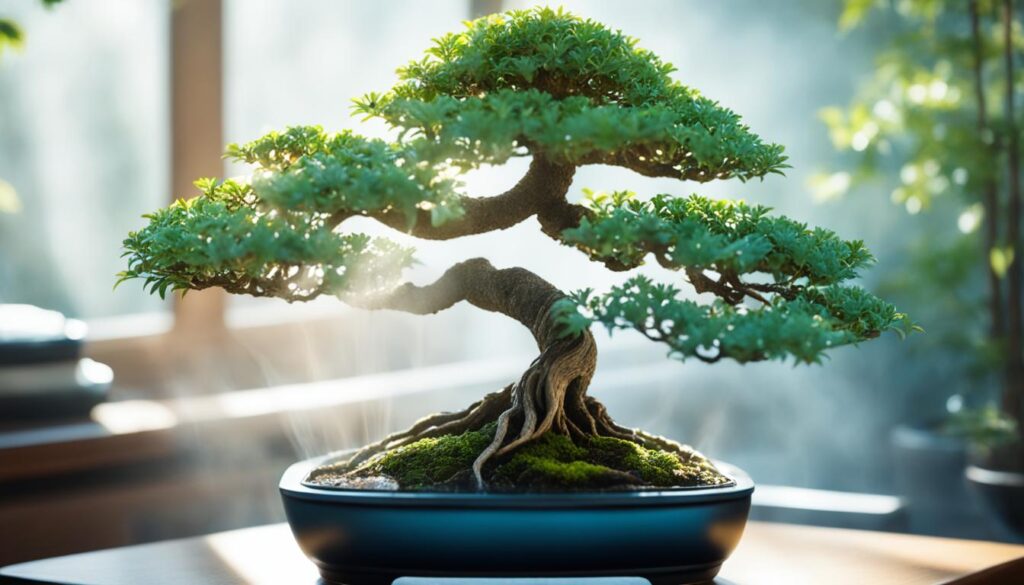
Watering and Fertilizing Indoor Bonsai
Keeping your indoor bonsai trees healthy means paying attention to their watering and fertilizing needs. Since bonsai have less soil than regular plants, you need to check the soil moisture more often. This is key for their well-being and long life.
Water your bonsai when it needs it, not just at the same time every week. Let the soil dry out a bit before watering again. But don’t let it dry out so much that the tree starts to wilt. Too much water can hurt your bonsai just like too little water can.
Fertilizing bonsai indoors is important to give them the nutrients they need. Use a slow-release fertilizer made for indoor plants. This kind of fertilizer gives your bonsai a steady supply of nutrients without giving them too much.
- Read and follow the fertilizer instructions closely. Adjust how much you use based on your bonsai’s size and the season.
- Fertilize every 2-4 weeks when your bonsai is growing. Cut back on fertilizing in the winter when it’s dormant.
- Watch how your bonsai reacts to the watering and fertilizing you give it. Change your routine as needed to keep it healthy and growing well.
“The key to successful indoor bonsai is finding the right balance between watering and fertilizing, tailored to the specific needs of your bonsai species.”
With a regular and careful watering and fertilizing routine, your indoor bonsai trees will flourish. They’ll keep bringing beauty and joy to your home.
Temperature Considerations
Keeping the right temperature is key for your indoor bonsai trees’ health and growth. The needs vary by species, with tropical and subtropical bonsai having different requirements.
Tropical Bonsai Species
Tropical bonsai trees, like the popular Ficus bonsai, do well in standard room temperatures. These tropical bonsai temperature ranges are usually between 60°F to 75°F. Keeping the indoor space stable within this range helps tropical bonsai thrive.
Subtropical Bonsai Species
Subtropical bonsai temperature needs are a bit different. Species like the Dwarf Jade or Fukien Tea bonsai prefer a cooler winter to mimic their natural dormancy. Keeping temperatures around 50°F to 55°F during the cold months helps meet their bonsai temperature requirements and promotes healthy growth.
Regardless of the species, big temperature changes can harm indoor bonsai trees. It’s important to watch the area near windows, vents, and heaters. This prevents your bonsai from getting too hot or cold, which can cause stress, leaf loss, or health problems.
“Maintaining the optimal indoor bonsai temperature is crucial for the thriving of your bonsai trees, as temperature variations can significantly impact their growth and well-being.”
Knowing what temperature your bonsai needs helps you create the best environment. This way, your indoor bonsai trees can reach their full potential.

Repotting and Pruning Indoor Bonsai
Keeping your indoor bonsai trees healthy and looking great means you need to repot and prune them often. These steps are key to keeping your bonsai looking good and staying the right size for your home.
Repotting Indoor Bonsai
It’s important to repot your indoor bonsai every 2-3 years. This refreshes the soil and lets the roots grow. It also helps the plant stay healthy and grow well. When you repot, use a special bonsai soil mix and a pot that’s just a bit bigger than the old one.
Pruning Bonsai Indoors
Pruning is key to keeping your bonsai in top shape. Cutting back the leaves and roots keeps your bonsai the right size and shape. It also helps the plant grow strong, focusing on the parts you want to highlight.
“Proper pruning and repotting are essential for the long-term success of indoor bonsai trees.”
Getting the timing right for pruning and repotting is very important. By doing these tasks regularly, you make sure your bonsai stays healthy and beautiful. This brings the beauty of nature right into your home.
- Repot indoor bonsai every 2-3 years to refresh the soil and provide room for root growth.
- Prune foliage and roots regularly to maintain the desired shape and size of the bonsai.
- Proper timing and techniques are crucial for the long-term health of indoor bonsai trees.
Styling and Shaping Techniques
Bonsai lovers use many styling and shaping methods to make their trees look unique and beautiful. These techniques help indoor bonsai owners reach their artistic goals for their trees.
Wiring
Wiring is a popular way to shape branches and trunks. By wrapping wires around the tree, bonsai artists can bend and place them as they like. This method gives quick results, letting the bonsai take the shape you want right away.
Defoliating
Defoliating, or taking off leaves, helps control the tree’s growth and looks. By removing leaves carefully, bonsai owners can make new growth, improve branch look, and highlight the tree’s shape.
Learning bonsai styling techniques, like bonsai wiring and bonsai defoliating, is key to shaping indoor bonsai into art.
“Waiting for another growing season may be necessary for sick or weak trees to respond positively to shaping, avoiding die back or tree weakening.”
Being patient and observant is crucial when styling bonsai. Having a clear idea of what you want before you start is important. Knowing about the tree’s nature and how it grows helps with successful styling.
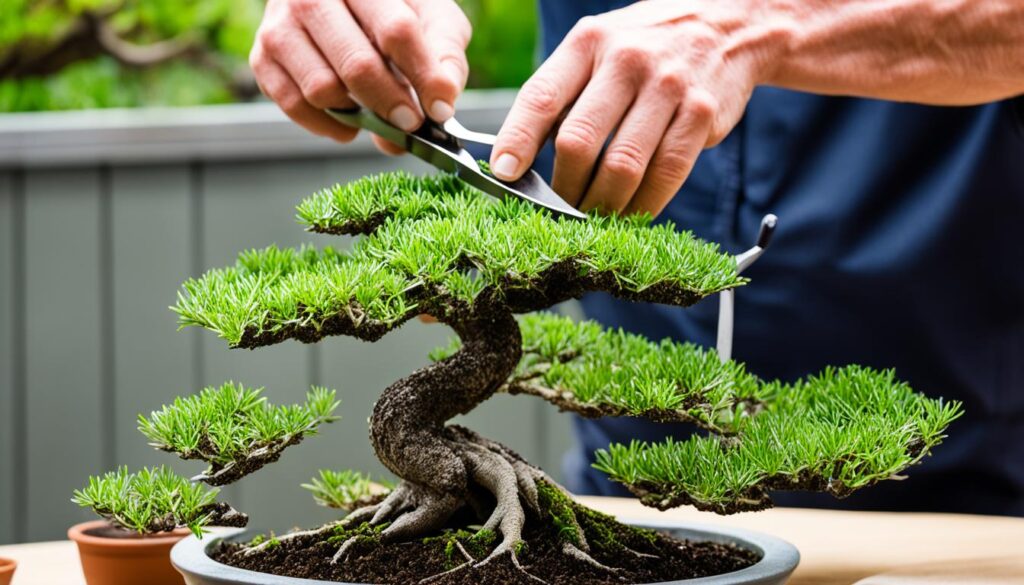
Using wire and the clip and grow method are common ways to shape bonsai trees. They offer quick results or a unique growth pattern, depending on what you aim for in styling.
Indoor Bonsai Display and Placement
Enjoying indoor bonsai trees means knowing how to display and place them. The right spot can make your bonsai look better and help it grow. The Altman Plants Classic Houseplant Collection on Amazon.com shows off 4 indoor bonsai trees. They highlight how these small trees can be versatile and beautiful.
Put your bonsai near a bright window or under extra lights for the best look. This ensures it gets enough sunlight to stay healthy and colorful. Using stands or pedestals can make your bonsai stand out even more.
Think about where you put your bonsai. Keep it away from where people walk a lot to avoid damage. Make sure it’s not near drafts or big changes in temperature.
“The key to a stunning indoor bonsai display is finding the perfect balance between aesthetics and optimal growing conditions.”
Choosing the right spot for your bonsai is key. By doing so, you can make a beautiful and lively indoor bonsai garden. This brings a piece of nature into your home.
The Assorted Succulents set on Amazon.com has 20 different plants. It shows the wide variety of indoor plants out there. By carefully placing your bonsai, you can make a beautiful and peaceful indoor space.
Troubleshooting Common Issues
Even the most careful indoor bonsai owners may face common problems with their trees. It’s important to watch closely and act fast to keep your bonsai healthy and thriving.
Pest Control
Pests like spider mites or scale insects can harm your indoor bonsai. Look out for webbing, discolored leaves, or sticky spots. If you see these signs, act quickly.
Insecticidal soaps or horticultural oils can help control pests. They keep your bonsai safe without harming it.
Disease Management
Diseases like fungal infections or nutrient shortages can hurt your bonsai. Watch for signs like yellow leaves, wilting, or color changes. Catching these early is key to fixing the problem.
Getting help from experts or resources is a good idea. They can guide you on how to fix your bonsai’s issues.
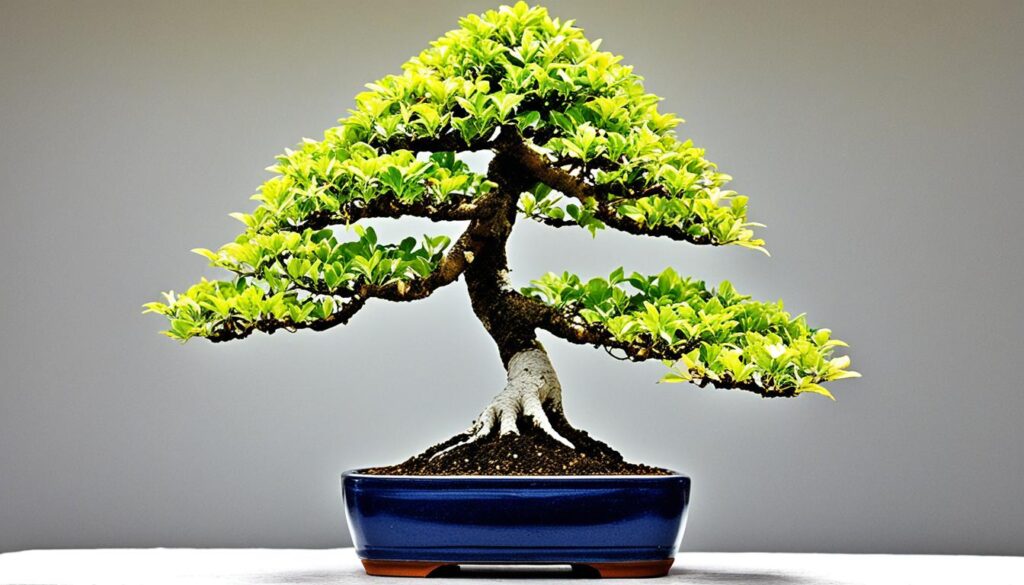
“The key to a thriving indoor bonsai is vigilance and a willingness to address issues head-on. By staying proactive, you can ensure your miniature tree remains healthy and vibrant for years to come.”
Remember, being patient and persistent is key when fixing bonsai problems. With the right steps and care, you can beat pests and diseases. Enjoy the beauty of your bonsai for a long time.
Choosing the Right Bonsai Pot
Finding the perfect bonsai pot is key for growing indoor bonsai trees. The material, size, and drainage of the pot affect the tree’s health and growth. It’s important to pick a pot that matches the bonsai’s size and gives enough room for its roots.
Here are some tips for picking the right bonsai pot:
- Oval and rectangular pots should be 2/3 the height of the tree. Round or square pots should be 1/3 the height, unless the tree’s leaves are very large. Then, the pot should be wider but shorter.
- Trident maples grow fast and need deeper pots than trees that don’t grow as much.
- Men’s pots are deep, angular, with strong lines and thick feet. Women’s pots have soft lines, thin feet, and are low and sleek.
- The pot’s color should match the tree’s bark, leaves, fruit, or flowers. Safe colors include brown, gray, and terracotta. Blue or cool green can add balance and make the display fresh.
Choosing the right pot is not just about looks. It’s also about keeping your indoor bonsai healthy and growing well. By picking the right bonsai pot, your tree will do great indoors and look beautiful in your display.
“The choice of the right bonsai container can make all the difference in the long-term success of your indoor bonsai tree.”
Indoor Bonsai for Beginners
For beginners, some bonsai species are easier to start with. The Ficus Bonsai, Dwarf Jade, and Fukien Tea are good choices. They are easy to care for and fit well in indoor settings.
Studies show that 72% of tropical and sub-tropical bonsai trees can live indoors. The Ficus is a top pick for beginners because it’s easy to care for. The Dwarf Jade is also great for beginners, being very low-maintenance.
Other good options include the Fukien Tea, Hawaiian Umbrella, and Sweet Plum. These trees do well in indoor conditions, offering a variety of choices for beginners.
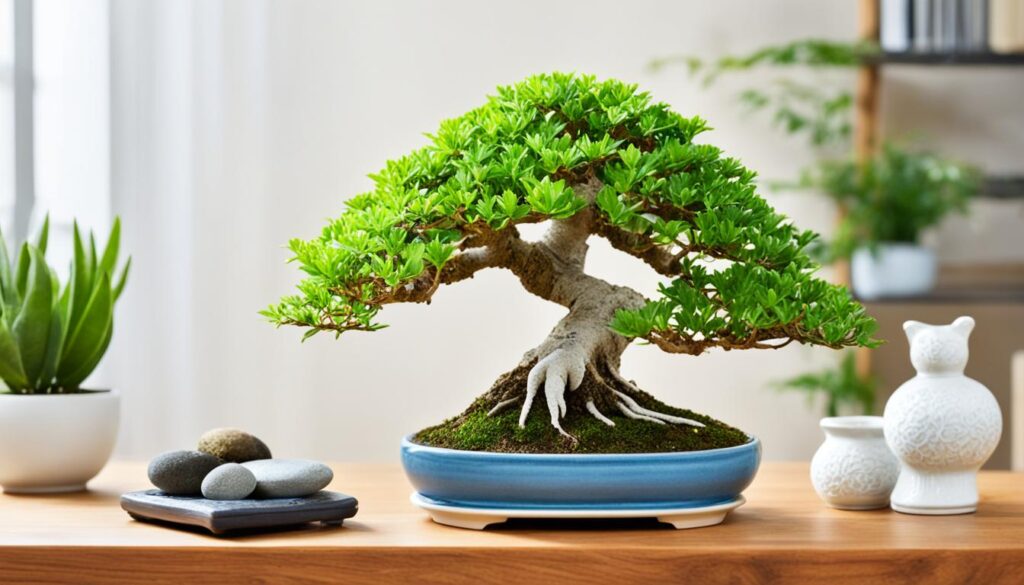
When starting with indoor bonsai, focus on the basics. Make sure they get enough light exposure, keep humidity levels right, and water them regularly. Following these steps, beginners can enjoy the beauty of bonsai at home.
“Bonsai is an art form that combines horticulture, design, and patience. With the right species and proper care, anyone can experience the joy of growing these captivating indoor trees.”
Begin with easy-to-grow species as you start your bonsai journey. With time and care, your bonsai can flourish, adding beauty and calm to your space.
Advanced Indoor Bonsai Techniques
As indoor bonsai lovers get more skilled, they might try advanced methods to make their trees look better and stay healthy. This includes complex styling and shaping, like wiring patterns, defoliating strategies, and ways to encourage certain growth patterns. They also look into mimicking nature by controlling humidity and temperature changes.
One key advanced technique is proper pruning. Pruning keeps the tree’s shape and helps it grow well. Growers need to learn how to prune, thin, and pinch to shape the tree right. Wiring is also important for setting the branches in the right place for the look you want.
“Over the last five years, the author became more convinced that adequate light is a critical element for long-term success with indoor bonsai.”
Good lighting is vital for growing bonsai indoors. While sunlight is best, many use supplemental artificial light, like fluorescent lights. These lights should be on for 16 to 18 hours a day.
Managing the environment is another important part of bonsai care. Growers must control temperature, humidity, and air flow to match the tree’s natural needs. This means cooling the area, raising humidity, and letting the soil dry out in winter.
Knowing how to water and fertilize is key for bonsai experts. Checking the soil, adjusting watering, and misting are important. Also, picking the right fertilizer and when to use it helps bonsai trees stay healthy.
Keeping bonsai safe from pests and diseases is also crucial. Growers should check their trees often, spot problems early, and use treatments to keep them healthy.
By learning these advanced techniques, bonsai lovers can improve their skills. They can create beautiful, thriving trees that bring nature indoors.
Conclusion
Indoor bonsai trees bring the beauty of nature right into your home or office. They are perfect for anyone who loves nature and wants to add beauty to their space. With the right care and techniques, you can grow stunning trees that last for years.
There are many types of indoor bonsai trees to choose from, like the tough Ficus and the beautiful Dwarf Jade. Each tree has its own needs, like how much light and water it needs. Knowing these needs helps keep your bonsai healthy and growing well.
Learning how to repot, prune, and style your bonsai is key to making it look great. With the right skills, you can shape your bonsai to match your space perfectly.
Starting your bonsai journey can be easier with help from experts. They can guide you in picking the best tree and solving problems. By following the indoor bonsai summary, key points about indoor bonsai, and final thoughts on growing bonsai indoors, you can make the most of your bonsai. This will help you create a peaceful, nature-filled space at home or work.
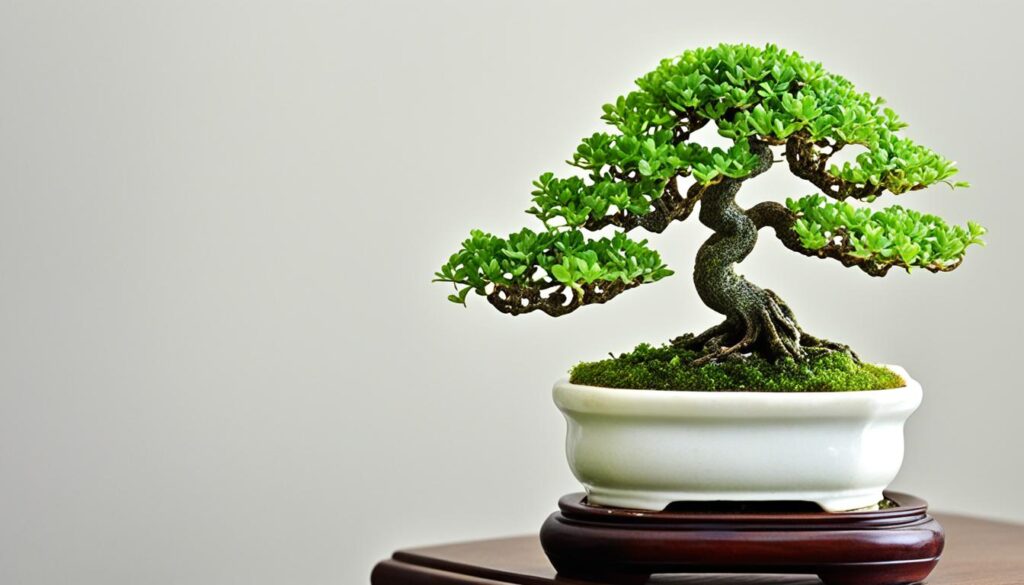


Can you be more specific about the content of your article? After reading it, I still have some doubts. Hope you can help me.
Thanks for sharing. I read many of your blog posts, cool, your blog is very good.